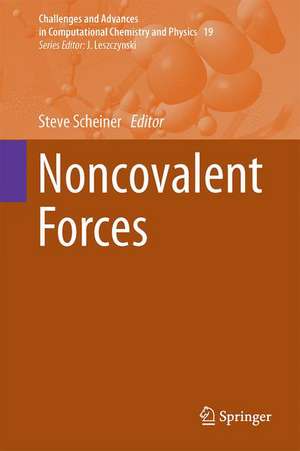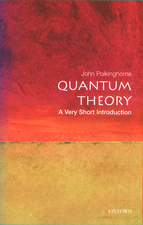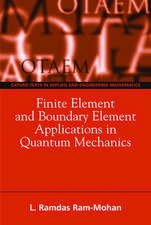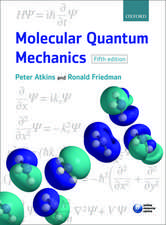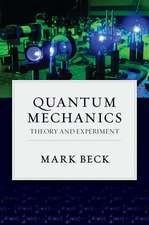Noncovalent Forces: Challenges and Advances in Computational Chemistry and Physics, cartea 19
Editat de Steve Scheineren Limba Engleză Hardback – 6 mai 2015
| Toate formatele și edițiile | Preț | Express |
|---|---|---|
| Paperback (1) | 1391.67 lei 6-8 săpt. | |
| Springer International Publishing – 13 oct 2016 | 1391.67 lei 6-8 săpt. | |
| Hardback (1) | 1398.00 lei 6-8 săpt. | |
| Springer International Publishing – 6 mai 2015 | 1398.00 lei 6-8 săpt. |
Din seria Challenges and Advances in Computational Chemistry and Physics
- 18%
 Preț: 952.09 lei
Preț: 952.09 lei - 18%
 Preț: 971.01 lei
Preț: 971.01 lei - 18%
 Preț: 1382.21 lei
Preț: 1382.21 lei - 18%
 Preț: 1278.02 lei
Preț: 1278.02 lei - 18%
 Preț: 1248.83 lei
Preț: 1248.83 lei - 18%
 Preț: 1831.42 lei
Preț: 1831.42 lei - 18%
 Preț: 1833.78 lei
Preț: 1833.78 lei - 18%
 Preț: 1827.80 lei
Preț: 1827.80 lei - 18%
 Preț: 2099.59 lei
Preț: 2099.59 lei - 18%
 Preț: 1234.62 lei
Preț: 1234.62 lei - 18%
 Preț: 2108.27 lei
Preț: 2108.27 lei - 18%
 Preț: 950.84 lei
Preț: 950.84 lei - 18%
 Preț: 1235.76 lei
Preț: 1235.76 lei - 18%
 Preț: 1246.78 lei
Preț: 1246.78 lei - 24%
 Preț: 1994.32 lei
Preț: 1994.32 lei - 18%
 Preț: 1226.73 lei
Preț: 1226.73 lei - 18%
 Preț: 2488.36 lei
Preț: 2488.36 lei - 18%
 Preț: 2484.74 lei
Preț: 2484.74 lei - 18%
 Preț: 1125.55 lei
Preț: 1125.55 lei - 18%
 Preț: 1119.87 lei
Preț: 1119.87 lei - 18%
 Preț: 786.36 lei
Preț: 786.36 lei - 18%
 Preț: 962.66 lei
Preț: 962.66 lei - 18%
 Preț: 1827.63 lei
Preț: 1827.63 lei - 18%
 Preț: 1114.34 lei
Preț: 1114.34 lei - 15%
 Preț: 643.16 lei
Preț: 643.16 lei - 18%
 Preț: 1105.82 lei
Preț: 1105.82 lei - 18%
 Preț: 1123.19 lei
Preț: 1123.19 lei - 24%
 Preț: 1070.77 lei
Preț: 1070.77 lei - 20%
 Preț: 1165.69 lei
Preț: 1165.69 lei - 18%
 Preț: 1115.94 lei
Preț: 1115.94 lei
Preț: 1398.00 lei
Preț vechi: 1704.87 lei
-18% Nou
Puncte Express: 2097
Preț estimativ în valută:
267.50€ • 280.05$ • 221.34£
267.50€ • 280.05$ • 221.34£
Carte tipărită la comandă
Livrare economică 05-19 aprilie
Preluare comenzi: 021 569.72.76
Specificații
ISBN-13: 9783319141626
ISBN-10: 3319141627
Pagini: 532
Ilustrații: VIII, 532 p. 256 illus., 200 illus. in color.
Dimensiuni: 155 x 235 x 35 mm
Greutate: 0.93 kg
Ediția:2015
Editura: Springer International Publishing
Colecția Springer
Seria Challenges and Advances in Computational Chemistry and Physics
Locul publicării:Cham, Switzerland
ISBN-10: 3319141627
Pagini: 532
Ilustrații: VIII, 532 p. 256 illus., 200 illus. in color.
Dimensiuni: 155 x 235 x 35 mm
Greutate: 0.93 kg
Ediția:2015
Editura: Springer International Publishing
Colecția Springer
Seria Challenges and Advances in Computational Chemistry and Physics
Locul publicării:Cham, Switzerland
Public țintă
ResearchCuprins
Ionic interactions.- Ionic H-bonds.- Interactions.- Unusual H-bonds.- Charge-inverted HBs.- Dihydrogen bonds.- Cooperativity on Supramolecular Level.- Moderate Strength.- Halogen bonds.- Chalcogen Bonds.- Pnicogen Bonds.- Aromatic.- Attraction.- Radicals.- Weaker Forces.- Aromatic stacking.- Rare gases.
Notă biografică
Currently, Prof. of Computational Chemistry, Utah State University, USA
Education
B.S. (Chemistry) City College of New York
May, 1972
A.M. (Chemistry) Harvard University
May, 1974
Ph.D. (Chemical Physics) Harvard University
Education
B.S. (Chemistry) City College of New York
May, 1972
A.M. (Chemistry) Harvard University
May, 1974
Ph.D. (Chemical Physics) Harvard University
Textul de pe ultima copertă
Computational methods, and in particular quantum chemistry, have taken the lead in our growing understanding of noncovalent forces, as well as in their categorization. This volume describes the current state of the art in terms of what we now know, and the current questions requiring answers in the future. Topics range from very strong (ionic) to very weak (CH--π) interactions. In the intermediate regime, forces to be considered are H-bonds, particularly CH--O and OH--metal, halogen, chalcogen, pnicogen and tetrel bonds, aromatic stacking, dihydrogen bonds, and those involving radicals. Applications include drug development and predictions of crystal structure.
Caracteristici
Covers the whole field Contributions from leaders in the area Contains applications on drug development Each chapter rigorously covers the material Includes supplementary material: sn.pub/extras
